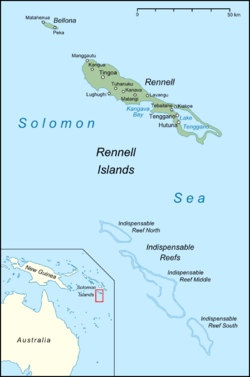Rennell and Bellona Province
| Rennell and Bellona | ||
|---|---|---|
| Province | ||
|
||
 |
||
| Coordinates: 11°40′S 160°10′E / 11.667°S 160.167°E | ||
| Country |
|
|
| Capital | Tigoa | |
| Government | ||
| • Premier | George Tuhaika (since December 2010) | |
| Area | ||
| • Total | 671 km2 (259 sq mi) | |
| Population (2009 census) | ||
| • Total | 3,041 | |
| • Density | 4.5/km2 (12/sq mi) | |
| Time zone | +11 (UTC+11) | |
Rennell and Bellona is a province of the Solomon Islands comprising two inhabited atolls, Rennell and Bellona, or Mu Ngava and Mu Ngiki respectively in Polynesian, as well as the uninhabited Indispensable Reef. Rennell and Bellona are both Polynesian-inhabited islands within the predominantly Melanesian Solomons. They are thus considered Polynesian outliers. The first known European to sight the islands was Mathew Boyd of Camberwell, London, commander of the merchant ship, Bellona, in 1793. The province has a combined population of 3,041 (2009 census). The Samoic language of the islands is, in English texts, called Rennellese. The capital is Tigoa on Rennell Island.
In 1793 Bellona Island was named after a passing British ship, the Bellona. Rennell Island may have been named for the oceanographer James Rennell, FRS (1742–1830). In 1799, according to a chart, both islands were named Bellona Island. In 1816 the islands were referred to as Rennell’s Isles.
The names the islanders used for self-reference are Mungiki (Bellona) and Mungava (Rennell), meaning small mountain and large island respectively (mu meaning "island" or "mountain", ngiki meaning "small", and ngava meaning "large"). Younger people on both islands sometimes use the name Avaiki for both islands.
According to oral traditions, the islands were originally inhabited by a people of another culture before the ancestors of present-day Polynesians arrived in canoes from their homeland, ‘Uvea Gago (probably Ouvéa in the Loyalty Islands, New Caledonia). On their voyage, they arrived at ‘Uvea Matangi (probably East ‘Uvea, or Wallis Island, in Wallis and Futuna), and finally reached Rennell Island, where they found no inhabitants. They were told by the high priest Tahasi that there was another island yet to be sighted and they left Rennell in search of it. They subsequently arrived at Bellona, where they found people, the Hiti, living in caves on the island near the shore. The Hiti were dark-skinned, short people with long hair reaching to their knees and spoke a language intelligible to the invaders, who gradually killed off the indigenous inhabitants. The oral traditions of Rennell and Bellona relate that the first invaders consisted of seven married couples who each founded a clan (sa’a), of which five became extinct. Ancestors of the two remaining clans, Kaitu’u and Iho, still inhabit the islands.
...
Wikipedia

